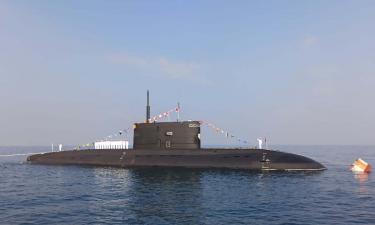“Nuclear kings” rejected his invention
 In 1950 he was the first to formulate the task of using guided nuclear reaction for peaceful atomic power energy.
In 1950 he was the first to formulate the task of using guided nuclear reaction for peaceful atomic power energy.
He was an ordinary soldier with no high education at that time.
He also developed the first reactor to which plasma was supposed to be attached by means of force field. However, the proofs of the inventions of this physicist were considered as lost. Only in 2001 the authority of the inventor was restored, after some classified documents were found in the archives of Russian President.
Physicist Lavrentiev became a recognized authority in his field, but nothing changed in his life. The founder of an entire scientific school was still working as chief research coordinator at Physics and Technical Institute in Kharkov, and his name was known only to a close circle of specialists.
In the Soviet times, Lavrentiev lived in Sakhalin island, and he sent the letter with his ideas to the Central Committee of Russian Communist Party –VKP(b). The letter was passed for reviewing to scholar Andrei Sakharov, who later became an academician and three times "Hero of Socialist Work".
Later Andrei Sakharov wrote, “This idea was the first one on this problem, and I was greatly impressed with its innovative spirit and audacity. The work by Lavrentiev stimulated speeding up the research I was conducted with Tamm on magnet thermo-isolation of high temperature plasma”.
Lavrentiev started studying at Department of Physics at Moscow State University, and simultaneously he was working at Kurchatov’s famous laboratory of measuring devices of Russian Academy of Science. He met many "nuclear kings", including Stalin’s close associate Lavrenti Berea who was chairman of the special committee in charge of elaborating atomic and hydrogenous weapons in the USSR. It seemed that Lavrentiev’s life was extremely successful. However, after Stalin’s and Berea’s deaths something changed in the secret world of nuclear research. Student Lavrentiev’s was rejected with his idea of a thermo-nuclear reactor to which plasma was supposed to be attached by means of force field, contrary to the reactors using magnet field. After graduating from Moscow State University with diploma with distinction, he left for Kharkov to work at the Physics and Technical Institute, and still works there.
For the long years of secrecy, intrigues in the field of science, changes of authorities, Lavrentiev, a citizen of Ukraine, had no chances to prove that he was the first one to come forward with his invention. The only proof was that old letter sent from Sakhalin island, but the officials always replied to his inquiries that the letter had been lost. However, in 2001 a Russian journal called Achievements of Physics Science published the documents found in Russian President’s archives. In 2003 Izvestia newspaper wrote about Lavrentiev, and this publication caused heated debates in Ukraine. The founder of the entire scientific school was not even Doctor as he did not want "to waste time on writing dissertation and going through bureaucratic formalities”, and his new project concept of “Elemag” thermo-nuclear reactor was only on the paper.
Recently, a book "The making soviet scientist" by Academician Roald Sagdeev was published in the USA. Roald Sagdeev came to the US in the Soviet times, he previously was the director of the Institute of Space Research, and was in the same year as Lavrentiev at Moscow State University.
“One of my most interesting roommates in the student dormitory’s room was a soldier who came to Moscow from the remote area of the country. His name was Oleg Lavrentiev, his was several years older than we, and the most important thing – he had some aura of mystery. He was bright, and was respected much. His behavior made an impression that he knew something we had no idea about. We all were sure that he was a genius working on something extremely secret. I found out what his secret was about, only after I graduated from university and started working at Kurchatov’s Institute of Atomic Energy. I think that Lavrentiev’s destiny is one of the most dramatic stories of the scientific revolution.
In March 2004 Ukrainian President Leonid Kuchma visited the Physics and Technical Institute in Kharkov. Lavrentiev was photographed with the President. In May the scientist was awarded the title “Honored person for Ukrainian science”. Lately he was conferred on Doctor of Science title, it took him only one month to write a dissertation. The dissertation’s subject is electrostatic snares which are being researched in the USA, Japan and South Korea. They are used in technologies, for producing isotopes in health care, in security devices for searching luggage for explosives or drugs. There are projects of using electrostatic drugs in space research as engines and sources of nuclear energy. Lavrentiev offered a number of traps with combined margins, added magnet field to the electric fields to provide magnet and hydrodynamic stability of plasma. He completed the series by developing the concept of a new nuclear reactor “Elemag”.
”Everybody will agree that Mr. Lavrentiev deserved being granted the title of Doctor 30 years ago”, said the reviewer of his dissertation, member of Ukrainian Academy of Science, deputy director of the Institute of Physics Igor Soloshenko. “I believe it would be unworthy to look for drawbacks in the dissertation. Criticizing Lavrentiev would be as ridiculous as criticizing the most prominent inventors. Moreover, Mr. Lavrentiev deserves more than just being a Doctor. He deserves Nobel Prize or at least our state’ prize. He initiated the entire school in power energy science!
Surprisingly, the idea of attaching plasma by electrostatic field, rejected by “nuclear kings”, is still popular. Scholars in the USA, Japan and Korea are working on this idea. An international reactor attaching plasma can be constructed rather soon. Was the Russian scholar right? The idea of guided nuclear synthesis has not been implemented so far.
Oleg Lavrentiev is concentrating on making producing nuclear reactor as cheap and simple as possible. The scholar elaborated a new project of Elemag nuclear reactor for 1 million kilowatts. This reactor is relatively simple and can be assembled from unified blocks.
What destiny will have the scholar and his invention in future? It is hard to say. Implementing scientific ideas requires support from the state. Businessmen call Oleg Lavrentiev and offer him to purchase a ready-made compact reactor, but they are not ready to invest in developing the project.
Valentin Gatash
Subscribe to Pravda.Ru Telegram channel, Facebook, RSS!




